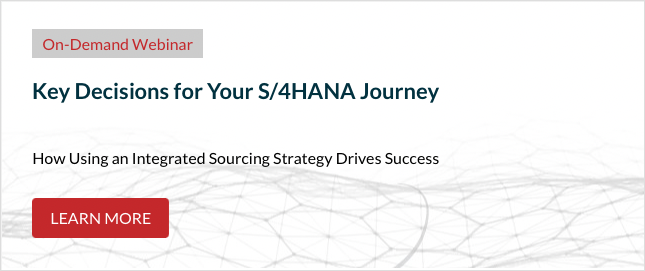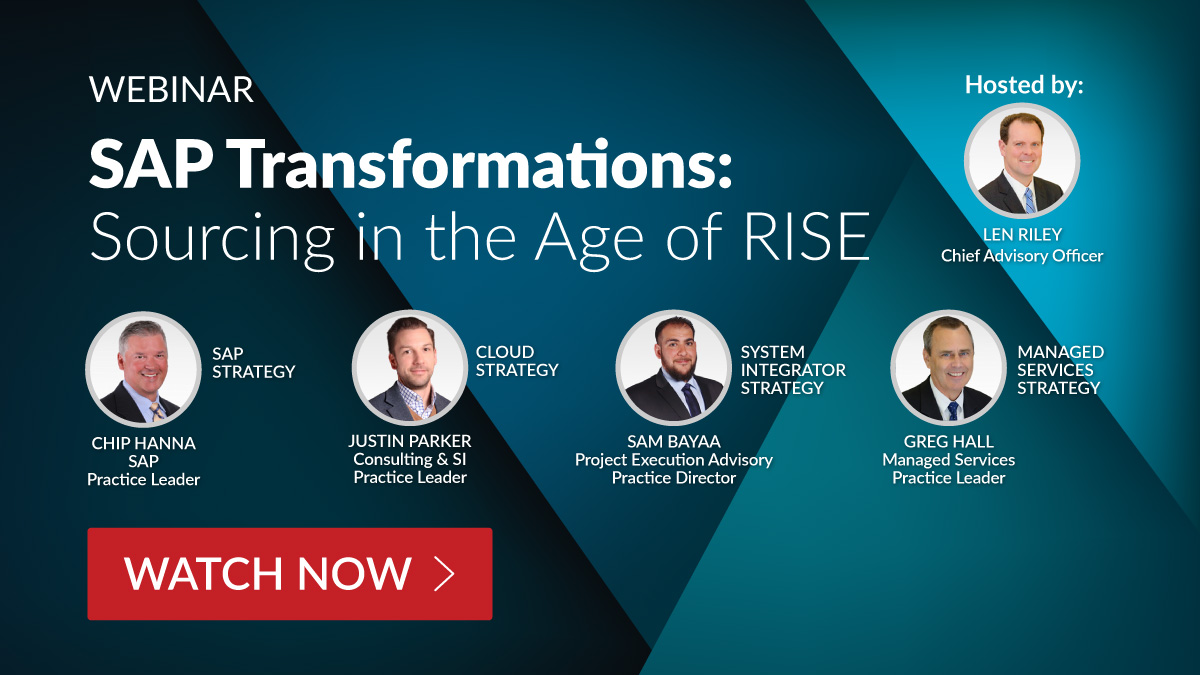- Chip Hanna
- Reading Time: 7 minutes

After SAP announced RISE with SAP earlier this year, many organizations were left confused by what constitutes the best use case for implementing RISE, what the “one handshake” contract model actually looks like, and how the transition to RISE affects each company and their overarching journey from ECC to S/4HANA.
Generally, organizations take a serial approach to the ECC to S/4HANA journey and look at it in four major steps: SAP software negotiation, implementation partner selection, hosting/hyperscaler partner selection, and application support partner selection. With RISE now in the picture, a serial approach to procurement or sourcing is effectively obsolete as the market is being driven towards bundled solutions.
Now, SAP customers are left wondering whether transitioning to RISE with SAP makes the most sense for their organization – does the business case pass muster? As a result, our customers raise several questions when considering the shift to RISE:
- Is RISE a viable option?
- Why are organizations shifting to hyperscalers?
- What are the benefits we’re seeing with RISE?
- What are the risks?
- What are the contractual structures under RISE?
Customers at all stages of their digital transformation process or those who have put off the ECC to S/4HANA migration may be considering RISE with SAP as a viable option. To make an informed decision, your organization needs to understand whether the business case exists for this transformation and what this transition entails. These are the key considerations your organization needs to keep in mind if you’re considering the transition to RISE.
What is SAP RISE?
SAP RISE takes a more holistic approach to digital transformation, promising a single offering that enables business outcomes via an Intelligence Enterprise enabled by S/4HANA and featuring one responsible party for service-level agreements, operations, and support.
RISE is presented in one commercial construct encompassing software, infrastructure, and technical services that are delivered by SAP and a hyperscaler. SAP also offers the application of your traditional AMS services and business process management as an optional service to take your solution even further.
RISE is SAP’s most SaaS solution for their core ERP that they have ever offered. They are attempting to drive more customers to the cloud, something SAP has been aiming to do for a long time now, while also driving customers into a subscription-based licensing model. With RISE, SAP is also adding in the infrastructure that underpins your core ERP application as well as the OS and database services that manage the technology under your S/4HANA core ERP.
Why RISE Now?
Client Objectives
SAP’s biggest objective with RISE is commercial simplicity. Existing SAP customers know their agreements always come with a negotiation and a complex current environment. RISE’s single offering structure is SAP’s attempt to move to a simpler commercial model.
Second, SAP is looking to drive operational simplicity. RISE features one responsible party for service-level agreements. In this way, SAP is attempting to take organization’s entire SAP ERP platforms and make them manageable by one group of people who are accountable for the platform’s application, the technology underneath the platforms, and their baseline technology services.
Lastly, SAP is aiming to establish technical enablement to allow for enhancements, bug fixes, and new releases to automatically appear on organization’s platforms. RISE is SAP’s solution to automatic updates already being implemented in the likes of Workday’s and Salesforce’s platforms.
SAP’s Objectives
First, SAP wants to reestablish account control. With service providers like AWS and Microsoft rising up the stacks as well as the departure of key SAP executives, SAP’s influence and control is being challenged. SAP leveraged the executive relationships built by Bill McDermont, Rob Enslin, and Jennifer Morgan to maintain control over their large, key account customers. They used those relationships to not only drive the roadmaps behind what customers were going to buy, but when those customers were going to buy. SAP was able to manage their clients as well as the pipeline and revenue associated with those clients. With the departure of these executives, SAP needed to reestablish account control to maintain its influence on the entire SAP ecosystem.
Additionally, SAP over time was able to successfully create the perception that ERP was the core of their customer’s IT universe. However, that perception does not necessarily hold true anymore as we find several customers prioritizing other platforms. ERP is no longer the beginning and end of an organization’s IT universe, and thus SAP has struggled to maintain this perception and the account control associated with it.
SAP’s next major objective is to obtain a larger share of the wallet. While SAP has led innovative solutions that have enabled every industry in the world and has created an ecosystem that has given rise to hundreds of complementary software and service providers, they’re learning that they need to go deeper and higher in how they wrap the complementary services that go around core ERP stacks.
The services that manage the application infrastructure are important, and SAP understands that they need to take control of these services, or the control will be taken from them by Microsoft, Google, and AWS as technology and infrastructure providers that offer a greater degree of services. SAP must become more nimble and more diverse while still making sure they retain account control over time.
What is the Difference Between RISE and HEC?
A key question has come out of the introduction of RISE: What is the difference between RISE and HEC?
HEC, in its purest form, takes your on-premise environment and lifts it into SAP’s infrastructure or into one of the hyperscaler’s infrastructures. SAP was very flexible around this process – organizations could bring their own license or could go with a subscription and they could utilize SAP’s infrastructure or a hyperscaler’s infrastructure. However, this flexibility led to a lot of confusion among customers, creating difficulties in decision making as to what was best for them.
There was also a lack of transparency and predictability around costs. Organizations looking to add users to their current environment did not know whether SAP would add these user licenses or require adding infrastructure to support new users. As a result, it wasn’t clear when organizations would have to pay for licensing or pay for infrastructure in the event the organization needed to add new users to their environment.
Accountability was an additional problem. SAP was very clear contractually with their customers that it sized their customer’s environments based on the information the customer provided. By doing this, the responsibility was placed on the customer if the platform did not perform. Under such circumstances, these contracts required the customer to pay to fix the platform, to fix the platform themselves, or to purchase additional infrastructure to bring its SLAs up to where they originally anticipated. The risk was on the customers to deliver the applications and the SLAs it needed from the start of their transformation.
Finally, living with SAP became a “death by a thousand cuts” experience. Customers encountered monthly and quarterly change orders, and it was not clear what was driving the change. This lack of predictability drove a high degree of frustration and led to a perception in the market that HEC was not a viable platform. SAP introduced RISE as a completely different approach to address these issues.
Key Considerations When Transitioning to RISE
If you are a longtime SAP customer, you know their agreements are highly negotiable, complex, and there is a lot to unpack. With RISE, SAP is trying to drive a much higher degree of standardization and less flexibility than in the past to make their agreements more predictable and simpler.
If you are an ECC customer considering the transition to RISE, you have some crucial steps to take before committing to that transition.
1. Understand the value of your current ECC entitlements and how to translate your technical and business capabilities from your on-premise environment to your cloud entitlements
When transitioning from S/4HANA licensing to the RISE licensing, you must translate your current entitlements to what is considered a full user equivalent license. Each use type is aligned to a certain amount of functionality that you have access to within your core ERP, and these full user equivalent licenses drive your system sizing. The challenge your organization has is understanding how you get your baseline set and transparent for this transition.
2. Understand what your future looks like
With RISE, there are different volume clip tiers that may require you to purchase up a tier when you need to add additional users. Thus, it’s important to understand what your future requirements are and get to the transparency and predictability you need in order to manage your portfolio now and overtime.
Understanding your future requirements is also crucial because customers that have enjoyed SAP’s flexibility in the past will want to maintain that flexibility as they move forward in order to manage their applications and their infrastructure across their portfolio overtime. Regarding flexibility, SAP has been very clear that they’re going to be flexible in maintaining a level of optionality for hyperscalers. This makes it easier on customers who have a great relationship with other service providers to bring that relationship with them in the RISE transition without feeling commercially penalized.
3. Contracts and costs
Again, SAP is trying to present a more simplified contractual structure with this new offering. One of SAP’s main objectives with RISE is to make their agreements easier on customers and ensure the agreements are set in a way that makes it a less complex process. SAP’s solution to this is one set of agreements for your entire digital transformation. However, there is still a lot of complexity to that one set of agreements, so it’s important to understand where you were contractually in your prior SAP agreements and where you are going over time.
4. The switch to subscription-based licensing
Under RISE, you will have to forfeit your perpetual license agreement for a subscription-based model. Once you have a subscription-based license that is integrated into the RISE technology stack and infrastructure, you will have to know how you got there in order to successfully unwind that integration. Under the subscription-based model, organizations cannot walk away from part of the agreement – once you stop paying, you stop having the right to use the software. Thus, it is essential for the customer to understand what their RISE journey looks like and get that transparency and flexibility from SAP while also understanding what limitations they have if they were to decide that RISE is no longer the solution for them.
Bottom Line
Truthfully, SAP is struggling to make these initial financial proposals work, and it’s going to need to become more creative to make it feasible. Regardless, SAP is going to continue to push RISE in order to regain account control, obtain a larger share of the wallet, and consolidate the market. As a result, customers need to be informed about what is possible with RISE to get the most viable financial model they can if they decide to implement this new offering.
The main takeaway is to position your organization not to be overwhelmed by all the different offerings that have come out of the introduction of RISE with SAP. Think through how you want to funnel all these offerings into a strategy that you’ve already thought through in a sequence that helps your decision making, as opposed to driving the outcomes the vendor community is trying to drive. At the end of the day, this is all about decision making and providing decision support.
Comment below, find my other UpperEdge blogs and follow UpperEdge on Twitter and LinkedIn. Learn more about our SAP Commercial Advisory Services.

